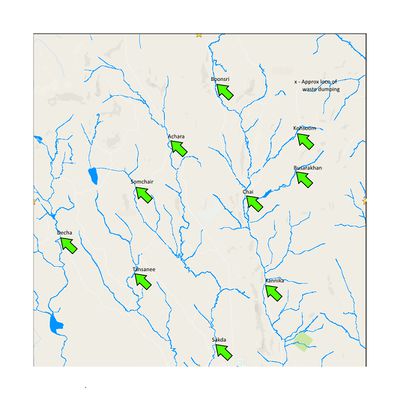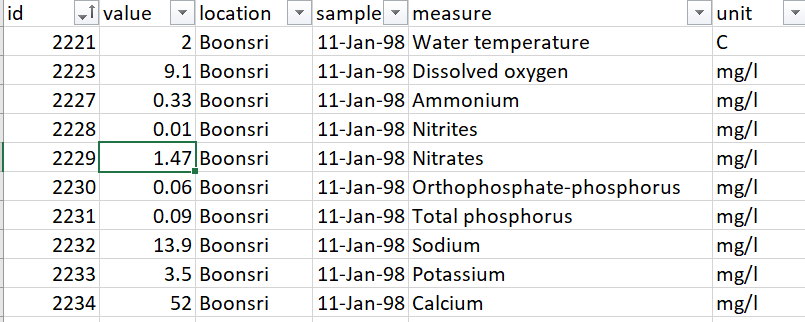Difference between revisions of "ISSS608 2017-18 T3 Assign See Kwan Yen"
| Line 66: | Line 66: | ||
<br> <b> Data description and map</b> | <br> <b> Data description and map</b> | ||
| − | There are a total of 136.824 rows of data and they are split into 5 columns below. | + | <br>There are a total of 136.824 rows of data and they are split into 5 columns below. |
There is another file with measure units. It was joined together with the original data file. | There is another file with measure units. It was joined together with the original data file. | ||
| Line 74: | Line 74: | ||
<b>2.Units</b> | <b>2.Units</b> | ||
| − | The chemical units are measured in Celsius, miligram per liter or microgram per liter. | + | <br>The chemical units are measured in Celsius, miligram per liter or microgram per liter. |
<b>3.Measure</b> | <b>3.Measure</b> | ||
| − | Chemicals (e.g., Sodium) or water properties (e.g., Water temperature) measured in the record | + | <br>Chemicals (e.g., Sodium) or water properties (e.g., Water temperature) measured in the record |
There are a wide range of 106 chemicals being detected by the sensors over the years. | There are a wide range of 106 chemicals being detected by the sensors over the years. | ||
<b>4.Sample date</b> | <b>4.Sample date</b> | ||
| − | Date sample was taken from the location | + | <br>Date sample was taken from the location |
<b>5. Value</b> | <b>5. Value</b> | ||
| − | Measured value for the chemical or property in this record | + | <br>Measured value for the chemical or property in this record |
Sample data from Excel file: | Sample data from Excel file: | ||
| − | [[File:Data sample.jpg| | + | [[File:Data sample.jpg|400px|framed|left]] |
Revision as of 17:04, 8 July 2018
|
|
|
|
|
|
Overview
Mistford is a mid-size city is located to the southwest of a large nature preserve. The city has a small industrial area with four light-manufacturing endeavors. Mitch Vogel is a post-doc student studying ornithology at Mistford College and has been discovering signs that the number of nesting pairs of the Rose-Crested Blue Pipit, a popular local bird due to its attractive plumage and pleasant songs, is decreasing! The decrease is sufficiently significant that the Pangera Ornithology Conservation Society is sponsoring Mitch to undertake additional studies to identify the possible reasons. Mitch is gaining access to several datasets that may help him in his work, and he has asked you (and your colleagues) as experts in visual analytics to help him analyze these datasets.
Mini-Challenge 2
Last year, the Kasios Furniture Company was implicated in environmental damage to the Boonsong Lekagul Wildlife Preserve for both dumping toxic waste and polluting the air with chemicals from its manufacturing process. But Kasios is not taking these accusations lying down, and they deny any accusation of industrial waste dumping! Kasios’ spokespersons state that there isn’t any ground contamination near the remote ranger station that was suggested by last year’s mini-challenge 1 and 3 participants, and they have inspected that area and found it as pristine as the rest of the preserve.
Outraged ornithology professors from Mistford College journeyed out to look over the dumping site themselves and perform soil analyses. They returned to report that the site looked like there had been recent excavation and building activities going on. Boonsong Preserve rangers later confirmed that a new ranger station was being built at that site! Soil samples taken from the site were inconclusive in detecting Methylosmolene (the toxic manufacturing chemical in the suspected dumping) or any other contaminant, as new top soil had been trucked in
With a primary piece of evidence against Kasios now gone, investigators will need to take another approach. Professors in the Mistford College Hydrology Department have come forward with several years of water sensor readings from rivers and streams in the preserve. These samples were taken from different locations scattered throughout the area and contain measurements of several chemicals of possible interest, but they have never been analyzed due to lack of funding. Could visual analytics help reveal something in this data that could make up for the soil evidence that was destroyed?
Problem Statement
Your task is to investigate the hydrology data from across the Preserve. You are given a map of the Preserve (with the same base as last year’s challenge), with named sampling sites indicated on the map (the names have local significance, but are just mnemonics for your study) You are also provided with readings from each sampling station over time for several different chemicals and water properties.
Questions:
- Characterize the past and most recent situation with respect to chemical contamination in the Boonsong Lekagul waterways. Do you see any trends of possible interest in this investigation?
- What anomalies do you find in the waterway samples dataset? How do these affect your analysis of potential problems to the environment? Is the Hydrology Department collecting sufficient data to understand the comprehensive situation across the Preserve? What changes would you propose to make in the sampling approach to best understand the situation?
- After reviewing the data, do any of your findings cause particular concern for the Pipit or other wildlife? Would you suggest any changes in the sampling strategy to better understand the waterways situation in the Preserve?
Mini Challenge 2 Background
View the interactive Tableau design here: Link to tableau dashboard
Data description and map
There are a total of 136.824 rows of data and they are split into 5 columns below.
There is another file with measure units. It was joined together with the original data file.
1. Locations
Based on the data description and reserve map, the waterway locations are shown below.
2.Units
The chemical units are measured in Celsius, miligram per liter or microgram per liter.
3.Measure
Chemicals (e.g., Sodium) or water properties (e.g., Water temperature) measured in the record
There are a wide range of 106 chemicals being detected by the sensors over the years.
4.Sample date
Date sample was taken from the location
5. Value
Measured value for the chemical or property in this record
Sample data from Excel file:


